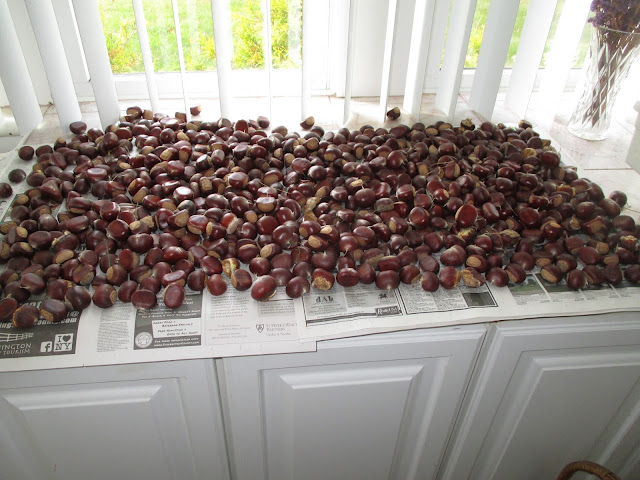Every year in early October my wife, a friend and I spend a few days on the northeast tip of Cape Cod. This year our daughter, Zoe, accompanied us and joined me in my annual trek from the Highland Lighthouse to a bet east of Race Point and then into Provincetown.
 |
| View of the Angry Ocean at Our Entry Point: Wind >30 mph |
 |
| North Tip of Cape Cod with Red Tracing the Route We Walked |
 |
| Typical View of the Northeast Shore of Cape Cod: Sandy Beach Terminated with a High Dune Covered in Vegetation. This is Part of the Cape Cod National Seashore with Few Road Access Points. Every Year the Ocean Reduces the Width of the Beach and Consumes Ever More of the Dunes |
Every year the trek is different: beach conditions, number of marine animals and birds, amount of seaweed at the high tide line and the varieties/quantities of flotsam and jetsam. We collect a variety of "bait bags" every year and keep them in hopes of finding uses for these rugged net cylinders. They are usually drawn closed at one end with a drawstring at the other end and come in many lengths and diameters. They are used to hold fish heads or other bait inside lobster, crab and shrimp traps. Most prized are those that are pristine or of an unusual color: purple and peach this year. Those that have been torn apart by crustaceans or too weathered don't make it home. Many have been probed by hundreds of pincers and have wear rings with broken strands of the strong twine they are made of. Each one has hundreds of bowline knots that form the netting with pinkie-size holes.
 |
| The 39 "Bait Bags" We Brought Home This Year Showing that Orange Was the Most Popular Color: Last Year Yellow Was More Common. |
 |
| A Strong Bag That Uses Heavy Twine |
 |
| Closeup Showing the Bowline Knots |
 |
| A Lightweight Bag Made with Slender Twine |
 |
| Our Peach Color and Purple Bags |
We no longer bring home foam floats that mark each trap and enable retrieving. This year we saw more than 200, many pristine, along the 12 mile beach we travelled. We did keep a few shiny plastic buoys and an inflatable bumper that we'll use on our pond or for making molds.
 |
| Hard Plastic Floats and an Inflatable Bumper |
We also collected a variety of balls and other plastic items that we hope will become dog toys or other uses. Most valuable are unbroken bins that fisherfolk use to pack fish and lobsters. They are very rugged and readily carry 100 pounds of fruit or vegetables.
Every lobster trap has a rope connecting it with the float at the surface. The lower half is usually more coarse than the top half. Over the years we've collected so much of this rope we only keep almost new examples of the fine variety that is easy to handle with bare hands.
 |
| A Pristine Football and other Plastic Objects Worth Bringing Home of the Many Thousands of Similar Objects Strewn Along the Beach |
 |
| Fish Bins: Great for Harvesting Fruits and Veggies |
 |
| Two Lengths of 3/8 inch Diameter Rope |
 |
| A Piece of New Netting That May Decorate a Wall Someday |
The most exciting find this year was not plastic but the remains of a reptile: probably a leatherback turtle. The length of the carapace was more than four feet. Its head was gone but the shell and other bones were still intact, though seagulls were hard at work removing anything edible.
 |
| Probable Leatherback Turtle Carcass |
For many years there were sandbars about two miles north of the highland light that attracted a hundred or more gray seals at low tide. This year these had disappeared along with the seals, though there were individual seals watching us from the water almost the whole way. A few miles farther north we did find the large colony on the beach.
 |
| A Large Colony of Gray Seals, with a Few Harbor Seals Mixed In |
Beaches concentrate and collect stuff that floats. High tides push it into a windrow as far up the beach as it can. This year the seaweed that has gas bladders to make it float dominates stuff generated by people. We seem to be working hard to compete with garbage and trash - most of it some form of plastic: bottles, take-out foam clamshells, various containers. There are also toys, parts of boats, homes, docks and clothing. There are no longer any tampon insertion devices that a few years ago were the most common objects. So we are making some progress. But not in reducing the number of balloons/ribbons that wash up. We saw about one every 150 feet or so, sometimes in clusters. The ribbons may be worse than the balloons because they last so much longer. Once on the beach, though, they eventually get buried in the sand by waves, no longer a threat to wildlife.




































